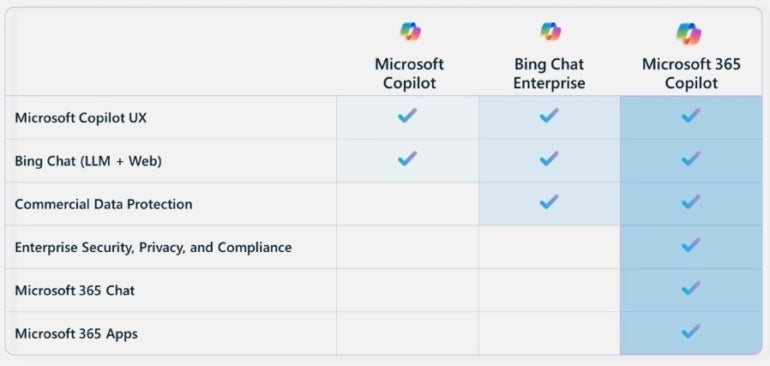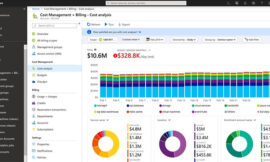The practical application of generative artificial intelligence has gone from an abstract, future concept to a concrete reality in a matter of mere months. Businesses and organizations large and small are scrambling to figure out if and how AI can help their people be more productive and efficient. For organizations using Microsoft software, the application of AI in a business environment is being led by the Microsoft Copilot platform.
Businesses at the enterprise level are also looking for ways AI can leverage the massive amounts of data generated daily by their organizations in increasingly productive ways. Many believe that such a massive undertaking can only be accomplished by a competent AI platform. Microsoft Copilot, with its integration into Microsoft 365, Azure, Windows and enterprise-wide data streams, is purported to be the AI that unlocks the creative and productive potential of an organization’s people and data.
Jump to:
What is Microsoft Copilot?
Microsoft Copilot is a new AI product that combines the power of large language models with in-house enterprise data generated by the Microsoft Graph and Microsoft 365 applications. Using the power of AI and natural language conversations, users can find better answers to their questions and potentially create content from those answers. Copilot was developed on the ChatGPT platform and announced as an in-development platform at the July 2023 Microsoft Inspire conference.
There are two versions of Copilot: Microsoft 365 Copilot and a more general Microsoft Copilot. It is important to note that Microsoft 365 Copilot is different from the consumer and small business-oriented Copilot platform found in Bing Chat or non-enterprise versions of Microsoft 365. These Copilot LLMs are trained on more generalized aggregate data gathered across the internet and therefore tend to have more generalized results. Microsoft 365 Copilot will be dependent on the data generated by a specific, and only a specific, enterprise.
Microsoft 365 Copilot will be dependent on in-house, enterprise-generated data, while the more general Microsoft Copilot will use aggregate data pulled from the internet.
Both Copilot versions will be embedded in the Microsoft 365 apps including Word, Excel, PowerPoint, Outlook and Teams. This complete Microsoft 365 integration will allow an organization’s workers to be more creative, unlock productivity gains and potentially improve their skills. In addition, Microsoft 365 Copilot will add AI-enabled Business Chat to the productivity suite, which will work across enterprise-specific data like calendars, emails, chats, documents, meetings and contacts to help employees communicate easier and better.
What are the versions of Microsoft Copilot?
There are three versions of Microsoft Copilot: Microsoft Copilot in Windows, Bing Chat Enterprise and Microsoft 365 Copilot.
Microsoft Copilot in Windows
This version of Copilot will allow you to use generative AI to create and complete tasks inside the Windows operating system and with Windows apps. Accessing Copilot will be available from the taskbar or with the Windows Key + C keyboard shortcut. Copilot in Windows will feature the new Copilot icon, the new Copilot user experience and Bing Chat.
Bing Chat Enterprise
Bing Chat Enterprise builds on the Microsoft Copilot foundation by adding commercial data protection, meaning business data is protected and will not leak outside the organization. With Bing Chat Enterprise, chat data is not saved, and Microsoft does not have access to it; in addition, your data is not used to train the large language models.
Microsoft 365 Copilot
Microsoft 365 Copilot builds on the Bing Chat Enterprise foundation, including enterprise-grade security, privacy and compliance to ensure all data processing happens inside Microsoft 365. The Microsoft 365 Copilot experience includes Microsoft 365 Chat, which combs across your entire universe of data (emails, meetings, chats, documents and more, plus the world wide web) to help you solve problems at work.
Microsoft 365 Copilot is also integrated into Microsoft 365 Apps like Word, Excel, PowerPoint, Outlook, Teams and more.
What are business benefits to using Microsoft Copilot?
Assuming Microsoft Copilot works as advertised, an employee could jump-start a project (e.g., email, presentation, report, data visualization) with an AI-generated first draft. With that foundation, the employee can quickly move on to refining and iterating a second draft and then a final draft, cutting at least one step from the process. This should make the employee more efficient and productive, and it could allow for the development of new skills.
For Microsoft 365 Copilot, the key to these productivity gains will be the application of enterprise-specific data to the new project from the start. Using data internally generated by the enterprise from emails, documents, calendars, contacts and so on, presumably the project will be jump-started with limited, and more importantly, pertinent assets.
SEE: Hiring kit: Prompt engineer (TechRepublic Premium)
For example, if an enterprise employee at Ford is creating a presentation that needs to show movement, the AI – if properly trained – should use a Ford-related product rather than a similar product from one of its competitors. An AI trained by data culled from the internet may come to a different conclusion and defeat the purpose of deploying enterprise-specific generative AI.
How does Microsoft plan to integrate Copilot into its applications?
Copilot will be integrated into the fabric of all Microsoft 365 applications. When an employee starts a Word document, reads an email in Outlook, opens an Excel report or updates a PowerPoint presentation, Copilot and its generative AI abilities will be there to assist when called upon.
The specifics of how each Microsoft 365 application will use Copilot are still in development, and many use cases will likely only be discovered when users can actually use the platform. However, Microsoft has outlined some of its basic ideas for Copilot in a business environment.
Below are examples of commands a user might give Microsoft Copilot.
Copilot in Word
- Draft a two-page project proposal based on data gleaned from a Word document (i.e., either the one you are currently working on or one that you specify by name) and an Excel worksheet.
- Make the third paragraph in the current document more concise and change the tone of the document to be more casual.
- Create a one-page draft based on this rough outline.
Copilot in Excel
- Break down this sales data by type and channel and then insert a table.
- Project the impact of a variable change in this data and then generate a chart to help visualize it.
- Model how a change to the growth rate for a variable would impact my gross margin.
Copilot in PowerPoint
- Create a five-slide presentation based on this Word document and include relevant stock photos.
- Consolidate this presentation into a three-slide summary.
- Reformat these three bullets (in a specific PowerPoint presentation) into three columns, each with a picture.
Copilot in Outlook
- Summarize the emails missed while out of the office last week and flag any important items.
- Draft a response thanking the senders of an email and asking for more details about their second and third points.
- Shorten a draft email and make the tone more professional.
- Invite everyone to a lunch-and-learn about new product launches next Thursday at noon. Mention that lunch is provided.
Copilot in Business Chat
- Summarize the chats, emails and documents about the topic being discussed.
- What is the next milestone for a project? What risks were identified? Brainstorm a list of potential mitigations.
- Write a new planning overview in the style of this (specified existing) document that contains the planning timeline from a different document and incorporate the project list in the email from this person (specifying a user’s name).
What are potential problems and caveats with Microsoft Copilot?
All AI platforms are only as good as their training; if Microsoft Copilot is modeled after data that is incomplete, biased, wrong or otherwise corrupt, the suggestions it generates, regardless of who is asking, will be incomplete, biased, wrong or otherwise corrupt. The old adage of garbage in equals garbage out still applies.
For Microsoft 365 Copilot, training will be particularly important because all the data used for that Copilot AI platform will be internally generated and gathered. Enterprises looking to properly apply AI will have to carefully monitor the data Copilot can access. For example, a business may not want brainstorming documents and meeting notes to be part of the data stream; rejected ideas may taint the data stream and propagate throughout the organization.
For general versions of Microsoft Copilot, organizations and users will have to be aware that inherent biases, fads, misguided trends and other transitory events will likely color some of the AI-generated output. Not every passing fancy on the internet should make its way into official organizational documents.
In addition to this potential problem, especially for Microsoft 365 Copilot implementations, is the tendency of some departments to silo their data behind firewalls. New products and services developed under non-disclosure agreements, for example, will often be cut off from the normal organizational data stream. Businesses will have to decide whether hiding data from the AI in such cases is more beneficial than allowing AI access.
The most important caveat for Microsoft Copilot is the platform is still in development. The use cases outlined by Microsoft at the 2023 Inspire conference are the company’s visions of how the platform will work. Once Copilot is released to the public, what the AI platform is capable of, good or bad, will be revealed. Until then, we will be dealing with potential and perhaps some wishful marketing.
What are the alternatives to Microsoft Copilot?
Generative AI is arguably the hottest trend in technology innovation for 2023, so it stands to reason there are many new and in-development AI platforms ready to compete with Microsoft Copilot.
Even though Copilot is based on ChatGPT, the AI chatbot is available as a standalone platform and therefore should be considered a competitor. AI is already incorporated into Microsoft Edge in the form of Bing Chat, and an AI has recently been released for the Google search engine and Chrome. Technology experts have reported that Apple is developing its own AI platform. It seems that AI will be integrated into just about every digital application we use on a computing device.
Major tech companies including Salesforce, Oracle and Adobe are all working on AI platforms. There are also dozens of smaller independent developers working on their own versions of an AI platform. Plus, there are a multitude of AI competitors working on specialized platforms that will bind LLMs and generative AI principles to specific applications. Businesses will likely spend a lot of time wading through AI platform possibilities.
How much does Microsoft Copilot cost?
- Microsoft Copilot in Windows will be available to customers for free.
- Bing Chat Enterprise is available as a standalone for $5 per user per month
- Microsoft 365 Copilot will be $30 per user per month.
At first glance, Microsoft 365 Copilot’s price point seems expensive, but it is vital to remember this version of the platform is designed for large business enterprises. For a large enterprise with thousands of employees, and assuming the platform delivers what Microsoft promises, that $30 could end up being a bargain. That is a big assumption to make at this early point in development.
The consumer and SMB versions of Microsoft Copilot will likely be priced differently than the enterprise counterpart. Bing Chat, which is also based on ChatGPT, is available now and for free as an integral part of Microsoft Edge. It is also likely that some feature-restricted or otherwise modified version of Copilot will be available for SMBs too small to have meaningful in-house generated data available to train the AI platform.
The pricing for all the versions of Microsoft Copilot is likely to change as development of the platform continues. With the large number of competitors in the AI platform space, it seems almost certain the cost of these services will change significantly.
Which businesses should consider Microsoft Copilot, and which should not?
At $30/user/month, only certain large enterprises will be able to afford large numbers of employees subscribing to the Microsoft 365 Copilot platform. In addition to the subscription fee, such employers will also have to account for the extra expenses associated with generating, collecting and collating accurate and useful data for the AI and LLMs to train on. This is a major undertaking, and the decision to implement the Copilot platform will take a significant commitment.
Large enterprises will have to decide whether the productivity benefits of using the Microsoft 365 Copilot platform outweigh the initial costs of developing and maintaining the platform – and then paying for it indefinitely.
For individuals and small businesses with little to no LLM-ready data, the consumer level versions of Microsoft Copilot is available for free. Bing Chat is already available in Microsoft Edge for everyone. Some form of low-cost or no-cost version of Copilot will likely be available for certain versions of Microsoft 365.
Only time will tell if the generative AI capabilities of Copilot are worth the time necessary to use them.
When will Microsoft Copilot be available?
As of August 2023, Microsoft Copilot is in the testing phase of development. A limited number of organizations and Microsoft Insiders are testing the AI and providing feedback on what works and what does not work.
At a September 21st event in New York, Microsoft further solidified its plans for the various versions of the Copilot platform (Figure A).
Figure A

- Microsoft Copilot in Windows will be available to everyone on September 26.
- Bing Chat Enterprise is included in Microsoft 365 E3 and Microsoft 365 E5.
Microsoft 365 Copilot will be generally available for enterprise customers on November 1.
Source of Article



